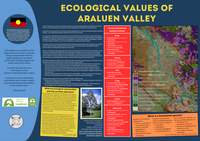Display Boards - Ecological Values of Araluen Valley
Ecological assessment
Araluen Valley has a unique microclimate compared to the adjoining Shoalhaven tablelands. It has mild winters and extremely hot summers, and its vegetation communities are quite distinct. As we learn more about the environment, we have developed more ways of assessing and describing the ecology – the relationship between organisms and their environment. And as we discover more, we learn that there is more to know. The display board has an amalgam of information about Araluen Valley from the ways that the NSW Government and the Commonwealth Government do ecological assessments.
The map shows plant community types (PCTs) of the Araluen Valley as recognised by the NSW Government to support biodiversity assessment, conservation planning and land management activities. PCTs identify and describe recurring patterns of native plant species assemblages in relation to environmental conditions such as soil, temperature, moisture, and other factors. At a broader level of environmental assessment, the Australian Government uses ecological communities (see What are ecological communities and why are they
important?) and has recognised that Araluen Valley has both critically endangered ecological communities and endangered ecological communities. Araluen Creek itself is well vegetated with river-flat forest dominated by mature casuarina trees, although its condition is rated as poor as an ecological community due to a lack of diversity in the understorey. The valley floor is predominantly grassland with a mixture of native and exotic species. The eastern slopes are dominated by grassy woodland and the escarpment surrounding Araluen Valley is dominated by Araluen Scarp Grassy Forest. Critically Endangered Ecological Communities (under the Commonwealth Environment Protection and Biodiversity Conservation Act 1999 – EPBC) of Araluen Valley include:
- Natural Temperate Grassland of the South Eastern Highlands, a naturally treeless or sparsely treed community characterised by a dominance of native perennial tussock grasses, and usually a second, lower stratum of shorter perennial and annual grasses and forbs growing between the taller tussocks and there may be a third discontinuous stratum of even smaller forbs, grasses and cryptogams. Sedges and rushes may also occur; and
- Lowland Grassy Woodland in the South East Corner Bioregion – includes canopy trees Eucalyptus tereticornis (forest red gum) and/or Angophora floribunda (Rough-barked Apple).
Endangered Ecological Communities (EPBC) of Araluen Valley include:
- Araluen Scarp Grassy Forest in the South East Corner Bioregion – includes Eucalyptus tereticornis, E. Globoidea, Angophora floribunda; and
- Dry Rainforest of the South East Forests in the South East Corner Bioregion – small remnants of Ficus rubiginosa, Pittosporum undulatum.
For more information see "NSW plant community type classification";
What are ecological communities and why are they important?
An ecological community (EC) is a group of native plants, animals and other organisms that naturally occur together and interact in a unique habitat. Its structure, composition and distribution are determined by environmental factors such as soil type, position within the landscape/seascape (e.g. altitude/depth), climate, and water availability, chemistry, and movement (e.g. oceanic currents). Species within each ecological community interact with and depend on each other—for example, for food or shelter. Listed ecological communities include grasslands, woodlands, shrublands, forests, wetlands, marine, ground springs and cave communities.
Ecological communities are important because of their unique combination of native biodiversity, distinctive landscape/ seascape values, vital habitat qualities and for the ecosystem services they provide. These include the natural management of air, water and soil nutrients; the reduction or control of erosion and salinity; provision of breeding/feeding habitat for species (e.g. for fish species) and carbon storage. Their natural values also contribute to the tourism and recreation industries and the productivity of farmlands and fisheries. In addition, ecological communities have strong cultural significance for both Indigenous and non-Indigenous Australians.
Source: Australian Government Department of Climate Change, Energy, the Environment and Water
Known threatened species include:
Birds
- Swift Parrot, Lathamus discolor, Critically Endangered
- Regent Honey Eater, Anthochaera phrygia, Critically Endangered
- Gang-gang Cockatoo, Callocephalon fimbriatum, Endangered
- Australasian Bittern, Botaurus poiciloptilus, Endangered
- Pilotbird, Pycnoptilus floccosus, Vulnerable
- Diamond Firetail, Stagonopleura guttata, Vulnerable
- White-throated Needletail, Hirundapus caudacutus, Vulnerable
- South-eastern Glossy Black-Cockatoo, Calyptorhynchus lathami lathami, Vulnerable
Plants
- Araluen Zieria, Zieria Adenophora, Endangered
- Hoary Sunray, Grassland Paper-daisy, Leucochrysum albicans subsp. Tricolor, Endangered
- Austral Toadflax, Toadflax Thesium austral, Vulnerable
- Araluen Gum, Eucalyptus kartzoffiana, Vulnerable
- Monga Ti-tree, Leptospermum thompsonii, Vulnerable
- Black Gum, Eucalyptus aggregata, Vulnerable
Fish
- Australian Grayling, Prototroctes maraena, Vulnerable
Frogs
- Southern Bell Frog, Litoria raniformis, Endangered (NSW)
- Booroolong Frog, Litoria booroolongensis, Endangered
- Giant Burrowing Frog, Heleioporus australiacus, Vulnerable
Insect
- Giant Fragonfly, Petalura gigantea, Endangered
Mammals
- Koala, Phascolarctos cinereus, Endangered
- Spot-tailed Quoll, Spotted-tail Quoll, Tiger Quoll, Dasyurus maculatus maculatus, Endangered
- Greater Glider, Petauroides volans, Endangered
What is a threatened species?
A species is considered threatened if: there is a reduction in its population size; it has a restricted geographical distribution; or there are few mature individuals. A species may be listed under the NSW Biodiversity Conservation Act 2016 as: vulnerable; endangered; critically endangered; or presumed extinct.
How threatened a species is in New South Wales depends on:
- the extent of its population reduction;
- the size of its geographical distribution; and
- the number of mature individuals.
Source: "About threatened species";, NSW Government Environment and Heritage
(which is part of the NSW Department of Climate Change, Energy, the Environment
and Water; formerly NSW Department of Planning and Environment)
See "Threatened species"; at NSW Government Environment and Heritage for
general information and links to other detailed information on threatened species in
NSW.
Araluen Gum, Eucalyptus kartzoffiana, listed as Vulnerable

Araluen Gum, Eucalyptus kartzoffiana, is listed as Vulnerable and only occurs
between Majors Creek and the Araluen Valley, N.S.W. It grows on dry, steep valley
slopes in granitic soil in sclerophyll forest.
Image courtesy of the Australian Plant Image Index, https://www.anbg.gov.au/photo
©Centre for Australian National Biodiversity Research
Also see: https://profiles.ala.org.au/opus/foa/profile/Eucalyptus%20kartzoffiana







